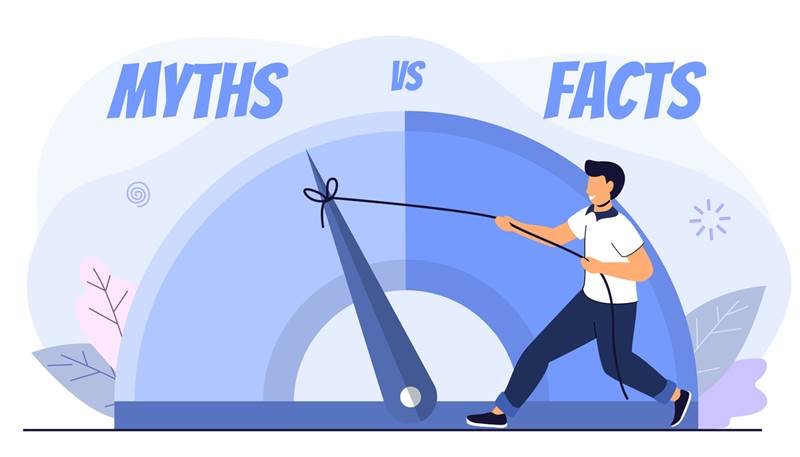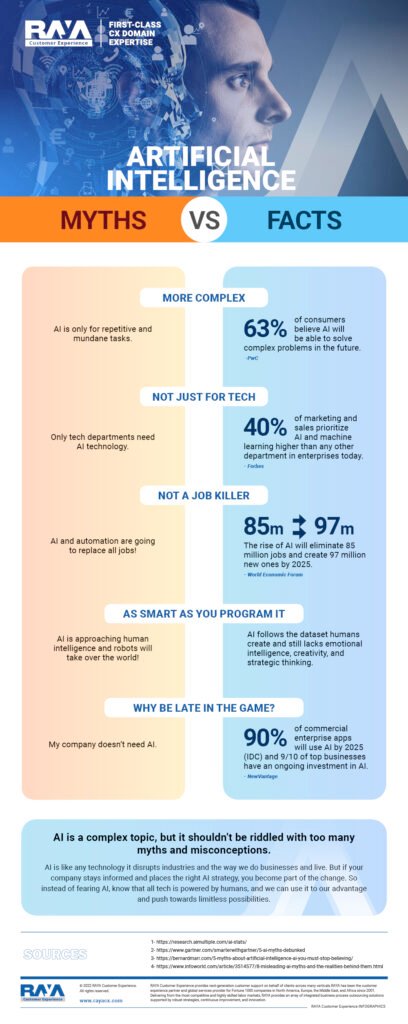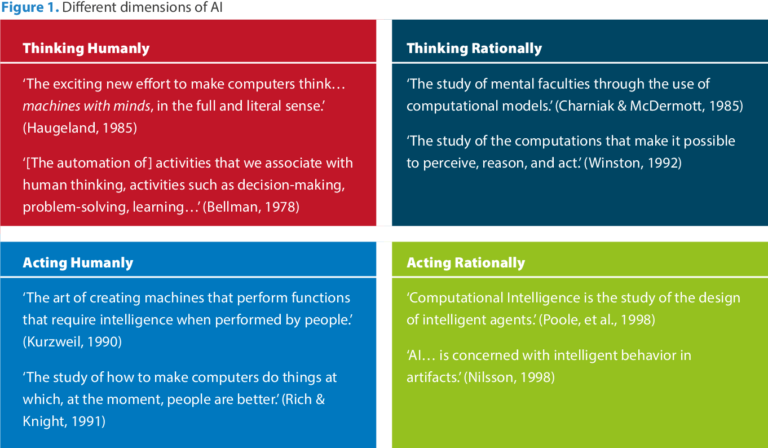The Myths And Realities Of Artificial Intelligence.

So, you’ve probably heard a lot about artificial intelligence (AI) lately, but you might be wondering what’s fact and what’s fiction. In this article, we’ll explore the myths and realities surrounding AI and provide you with some insights into this fascinating technology. From fears of robot takeovers to the promise of enhancing our lives, join us as we debunk common misconceptions and shed light on the true potential of artificial intelligence.

This image is property of www.sam-solutions.com.
Myth: Artificial intelligence will replace human jobs
Concerns about AI taking over human jobs
There has been significant concern surrounding the rise of artificial intelligence (AI) and its potential to replace human jobs. Many fear that AI will automate tasks and render human workers obsolete, leading to mass unemployment and societal upheaval. These concerns are understandable, as technological advancements have historically led to job displacement in certain industries. However, it is important to separate the reality from the exaggerated fears.
The reality of AI and job displacement
While it is true that AI has the potential to automate certain jobs, it is important to note that it will also create new opportunities. AI technologies are best suited for automating repetitive and mundane tasks, allowing humans to focus on more complex and creative aspects of their work. In fact, research suggests that rather than replacing jobs, AI will augment them, enabling humans to work more efficiently and effectively.
Additionally, adopting AI technologies can lead to the creation of entirely new industries and job roles, such as AI engineers, data scientists, and AI ethicists. The key lies in adapting to the changing landscape and equipping the workforce with the necessary skills to thrive in the age of AI. This includes investing in reskilling and upskilling programs to ensure that individuals can remain employable in a rapidly evolving job market.
Myth: AI is omniscient and infallible
The misconception of AI’s all-knowing abilities
One common misconception about AI is its portrayal as an all-knowing entity capable of knowing everything. This misconception stems from depictions in popular culture, where AI often possesses superhuman intelligence and can instantly access vast amounts of information. However, the reality of AI’s capabilities is far more nuanced.
Understanding the limitations of AI
AI systems, while powerful, are ultimately limited by the data they are trained on and the algorithms they follow. They excel at processing and analyzing large datasets, identifying patterns, and making predictions based on historical data. However, they are not inherently capable of independent thought or possessing knowledge beyond what has been programmed into them.
Additionally, AI systems are prone to biases present in the data they are trained on, which can result in skewed or unfair outcomes. It is crucial to recognize that AI is a tool that is only as reliable and accurate as the data it is trained on and the algorithms it follows. Therefore, human oversight and critical evaluation are essential to ensure that AI systems are used responsibly and ethically.
AI’s reliance on data and algorithms
AI systems rely heavily on data to function effectively. The quality and diversity of the data used to train AI models directly impact their capabilities. Additionally, the algorithms used to process and analyze this data play a crucial role in determining the outcomes and performance of AI systems.
It is important to emphasize that AI is not a standalone entity but rather a product of human ingenuity and engineering. AI algorithms are designed by humans who make deliberate decisions about what data to use, how to train the model, and what objectives to optimize for. This underscores the importance of responsible AI development and the need for human expertise in ensuring the fairness, reliability, and ethical use of AI technologies.

This image is property of assets.mofoprod.net.
Myth: AI will inevitably lead to robot uprising
Depictions of AI in popular culture
The idea of a robot uprising, where AI-powered machines overthrow human civilization, has been a recurring theme in science fiction and popular culture. Movies, books, and media often portray AI as malevolent entities seeking to dominate or destroy humanity. However, it is crucial to recognize the distinction between fiction and reality.
The reality of AI’s limitations in autonomous decision-making
While significant advancements have been made in AI technologies, the reality is that AI remains far from achieving true autonomy and consciousness. AI systems are designed to perform specific tasks based on pre-set rules and algorithms, and they lack the capability to make independent decisions outside of their programmed scope. They cannot develop motivations, intentions, or desires as depicted in popular culture.
Moreover, AI systems require constant human oversight and intervention to correct errors, refine algorithms, and ensure ethical use. The development of AI technologies is driven by human goals and objectives, and their deployment is subject to regulatory frameworks and ethical considerations.
Myth: AI is only for the tech-savvy
The misconception that AI is inaccessible to non-tech individuals
There is a common misconception that AI is a domain reserved exclusively for the technologically savvy and experts in the field. However, this notion is far from accurate. As AI technologies continue to evolve, efforts are being made to make them more accessible and user-friendly for individuals across various domains and industries.
The increasing democratization of AI technology
In recent years, there has been a democratization of AI technology, meaning that it is becoming more readily available and usable for individuals with varying levels of technical expertise. This is facilitated by the development of user-friendly AI platforms and tools that allow users to leverage AI capabilities without in-depth knowledge of complex algorithms or programming languages.
Furthermore, organizations and institutions are offering online courses and workshops aimed at introducing AI concepts and applications to non-tech individuals. By providing accessible educational resources, individuals from diverse backgrounds can gain a foundational understanding of AI and apply it to their respective fields.

This image is property of futureoflife.org.
Myth: AI lacks creativity and human-like intelligence
The belief that AI cannot replicate human creativity
Creativity is often seen as a uniquely human trait, leading to the belief that AI is incapable of replicating or exhibiting true creativity. While it is true that AI cannot possess the same subjective experiences and emotions that drive human creativity, AI has demonstrated remarkable capabilities in creative and innovative tasks.
Examples of AI-driven creativity and innovation
AI algorithms have been utilized to generate original pieces of art, compose music, and even write literature. These examples showcase AI’s ability to analyze patterns and learn from existing creations, enabling it to generate new and unique works. AI can assist human creators by providing inspiration, refining ideas, and augmenting the creative process.
In many instances, AI and human collaboration have led to groundbreaking innovations that would not have been possible with either working alone. The fusion of AI’s analytical capabilities and human imagination has the potential to drive breakthroughs in fields such as healthcare, design, and scientific research.
Myth: AI is a recent phenomenon
The historical roots of AI research
While AI has gained significant attention in recent years, its roots can be traced back to the mid-20th century. The field of AI research originated with the goal of developing machines that could simulate human intelligence and perform tasks that typically require human cognitive abilities.
Early pioneers in AI, such as Alan Turing and John McCarthy, laid the foundation for subsequent advancements. Over the years, researchers and scientists have made significant progress in developing AI technologies, with breakthroughs in areas such as machine learning, natural language processing, and computer vision.
The evolution and advancements of AI over the years
AI has undergone significant evolution and advancements since its inception. From rule-based expert systems to statistical learning algorithms, AI has evolved to become more sophisticated and capable. The advent of big data and advancements in computing power have further accelerated the progress of AI technologies.
Today, AI is integrated into various aspects of our daily lives, from virtual assistants and recommendation systems to autonomous vehicles and medical diagnostics. The field continues to evolve, driven by ongoing research, technological advancements, and the growing availability of data.

This image is property of www.techopedia.com.
Myth: AI is a single entity with a unified goal
The different types of AI and their purposes
AI is a broad term that encompasses various subfields and approaches. It is important to recognize that AI is not a monolithic entity with a single unified goal, but rather a diverse collection of technologies and methodologies. Different types of AI serve different purposes and exhibit varying degrees of autonomy.
There are three main types of AI: narrow AI, general AI, and superintelligent AI. Narrow AI refers to AI systems designed to perform specific tasks with a narrow focus. General AI, on the other hand, aims to replicate human-level intelligence and possess broad cognitive capabilities. Superintelligent AI refers to AI systems that surpass human intelligence in virtually every aspect.
The lack of a unified AI consciousness
It is crucial to understand that AI systems lack consciousness and self-awareness. They are programmed tools designed to analyze data and execute tasks based on predetermined rules and algorithms. Each AI system operates independently, focused on achieving its specific objectives, rather than working together with other AI systems towards a common goal.
The development and deployment of AI technologies require careful consideration of ethical considerations and social implications. It is the responsibility of human designers, engineers, and policymakers to ensure that AI systems are developed and utilized in a manner that aligns with societal values and promotes the well-being of humanity.
Myth: AI can solve all problems
The exaggeration of AI’s problem-solving capabilities
While AI has shown great promise in solving complex problems and making predictions, it is important to recognize that it is not a panacea for all challenges. AI technologies have limitations and are only as effective as the data they are trained on, the algorithms they employ, and the objectives they are optimized for.
The need for human input and critical thinking in AI systems
AI systems are not self-sufficient entities; they require human input and critical thinking to ensure their effectiveness and ethical use. Human expertise is indispensable in identifying biases, ensuring fairness, and mitigating unintended consequences that may arise from the deployment of AI technologies.
Moreover, AI systems are not capable of moral reasoning or ethical decision-making in the same way that humans are. The complexities of morality and ethical dilemmas require human judgment and deliberation. While AI can assist in processing and analyzing data, it is ultimately up to humans to make value-based decisions and consider the broader societal implications.

This image is property of rayacx.com.
Myth: AI is a threat to humanity
The portrayal of AI as a potential danger
The portrayal of AI as a potential threat to humanity has been a recurring theme in popular culture and media. Movies and books often depict AI as malevolent entities seeking to subjugate or eradicate humanity. However, it is important to distinguish between science fiction and the reality of AI technologies.
Ethical considerations and responsible development of AI
While it is crucial to remain cautious and vigilant regarding AI’s development, it is equally important to recognize the significant positive impacts AI can have on society. The responsible development and deployment of AI technologies require careful consideration of ethical guidelines and regulations to ensure transparency, fairness, and accountability.
Organizations and institutions involved in AI research and development are increasingly embracing ethical frameworks and guidelines to guide their practices. These frameworks emphasize principles such as fairness, transparency, accountability, and the well-being of individuals and societies. By adhering to these principles, we can harness the power of AI while mitigating potential risks.
Myth: AI will eradicate human creativity
The misconception that AI will eliminate human creativity
Many believe that the rise of AI will lead to the eradication of human creativity, as machines are perceived to be mechanistic and incapable of possessing the depth and complexity of human imagination. However, this notion overlooks the unique relationship between AI and human creativity.
The collaborative relationship between AI and human creativity
Rather than replacing human creativity, AI has the potential to enhance and augment it. By leveraging AI technologies, creators can access vast amounts of data, gain new insights, and explore innovative possibilities. AI can provide valuable assistance in tasks such as idea generation, content creation, and iterative improvement.
The collaboration between humans and AI systems can enable unprecedented levels of creative exploration and problem-solving. AI can generate alternative ideas, offer suggestions, and provide real-time feedback, allowing humans to refine their creative endeavors. The fusion of human intuition, subjective experiences, and AI-driven analytical capabilities can lead to breakthroughs and innovations previously unattainable.
In conclusion, separating fact from fiction is crucial in understanding the myths and realities of artificial intelligence. AI is not a monolithic entity, but rather a diverse collection of technologies with their own limitations and potential. While concerns about job displacement and ethical considerations are valid, AI also presents tremendous opportunities for innovation, problem-solving, and collaboration between humans and machines. By embracing responsible development and deployment of AI technologies, we can make strides towards a future where AI enhances and augments human capabilities, rather than replacing them.






